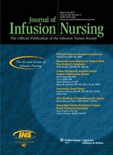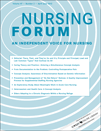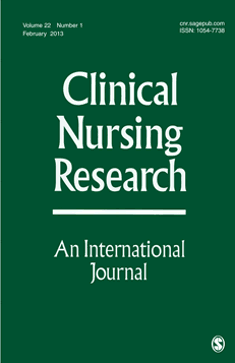
Journal of Infusion Nursing
Scope & Guideline
Fostering excellence in infusion nursing practices.
Introduction
Aims and Scopes
- Infusion Therapy Standards and Best Practices:
The journal publishes articles that establish and refine standards for infusion therapy, aiming to improve patient care and safety across various clinical settings. - Complications and Management of Vascular Access Devices:
A significant focus is on identifying, analyzing, and developing strategies to manage complications associated with peripheral and central vascular access devices. - Education and Professional Development for Nurses:
The journal promotes ongoing education and professional development for nurses involved in infusion therapy, highlighting the importance of continuing education and certification. - Implementation Science in Nursing Practice:
Research on the application of implementation science to improve nursing practices and patient outcomes in infusion therapy is a core area of focus. - Patient Safety and Quality Improvement Initiatives:
The journal emphasizes studies and reports on quality improvement initiatives aimed at enhancing patient safety in infusion therapy.
Trending and Emerging
- Use of Technology in Infusion Practices:
Recent publications emphasize the integration of advanced technologies, such as ultrasound and infrared imaging, in improving venous access and patient outcomes. - Evidence-Based Strategies for Complication Prevention:
There is a growing trend towards publishing evidence-based strategies aimed at preventing complications related to infusion therapy, particularly extravasation and catheter-related infections. - Patient-Centered Care and Experience:
An increasing focus on patient experiences and outcomes related to infusion therapy is evident, highlighting the importance of patient-centered approaches in nursing practice. - Quality Improvement and Implementation Science:
More articles are being published on quality improvement projects and the application of implementation science to enhance infusion practices and patient safety. - Interdisciplinary Collaboration in Infusion Therapy:
Emerging themes reflect the significance of interdisciplinary collaboration in managing complex cases involving infusion therapy, emphasizing the role of teamwork in healthcare.
Declining or Waning
- Traditional Vascular Access Techniques:
There has been a noticeable decline in publications focused on traditional methods of vascular access, such as standard venipuncture, as newer technologies and techniques gain traction. - General Nursing Practice Without Infusion Focus:
Articles focusing on general nursing practices that do not specifically address infusion therapy have become less common, indicating a narrowing of the journal's thematic focus. - Historical Perspectives on Infusion Therapy:
Research articles that provide historical insights or retrospective analyses of infusion practices are less frequent, suggesting a shift towards contemporary issues and innovations. - Pharmacological Studies Without Direct Infusion Relevance:
Studies that investigate pharmacological aspects unrelated to infusion practices are waning, as the journal increasingly prioritizes research with direct implications for infusion nursing.
Similar Journals

Journal of Pediatric Hematology-Oncology Nursing
Empowering nurses to transform pediatric hematology-oncology practices.The Journal of Pediatric Hematology-Oncology Nursing, published by SAGE Publications Inc, serves as a premier platform for advancing the field of pediatric nursing, particularly in the critical realms of hematology and oncology. With an ISSN of 2752-7530 and an E-ISSN of 2752-7549, this journal has quickly established its significance, achieving commendable rank status in various nursing specialties, including a Q1 placement in Advanced and Specialized Nursing as of 2023. It provides critical insights and evidence-based research across its converged years from 2022 to 2024, ensuring that professionals in the field remain at the forefront of best practices and innovations. The journal is especially relevant for nurses, medical professionals, and researchers aiming to improve patient outcomes in pediatric care. With open access options, it invites a broad readership to engage with its content, thus fostering collaboration and knowledge sharing in this vital area of healthcare.

Critical Care Nursing Clinics of North America
Exploring Breakthroughs in Critical Nursing Excellence.Critical Care Nursing Clinics of North America, published by W B Saunders Co-Elsevier Inc, stands as a leading journal in the field of critical care nursing, showcasing groundbreaking research and essential clinical practices since its inception in 1989. With an ISSN of 0899-5885 and an E-ISSN of 1558-3481, this quarterly publication has earned its reputation within the Q2 category of critical care nursing, ranking 13th out of 27 in the Scopus metrics. Its contributions significantly aid healthcare professionals in enhancing patient outcomes in critical settings through the dissemination of evidence-based knowledge, innovative approaches, and expert insights. Although it does not offer an Open Access model, the journal remains dedicated to serving researchers, practitioners, and students in understanding advancements and best practices within this dynamic specialty, with a focus on improving the quality of care in critical nursing environments.

NURSING FORUM
Advancing Nursing Knowledge, One Article at a Time.NURSING FORUM, published by Wiley-Hindawi, is a premier journal dedicated to advancing the knowledge and practice of nursing across diverse contexts. With an ISSN of 0029-6473 and E-ISSN 1744-6198, this esteemed journal has been a vital source of scholarly communication since its inception in 1961, serving researchers, practitioners, and educators in the nursing field. Recognized for its impactful contributions, it holds a prestigious Q1 ranking in Nursing (miscellaneous) and ranks #18 out of 139 in Scopus' General Nursing category, placing it in the top 87th percentile of its field. With its publication continuity from 1961 to 2024, NURSING FORUM promotes innovative research, evidence-based practices, and critical discourse essential for the nursing profession. This journal not only provides access to cutting-edge studies but also fosters a collaborative platform for healthcare professionals and academics to engage and share insights. Whether you are a seasoned researcher or a nursing student, NURSING FORUM is your essential gateway to the latest advancements and discussions that shape the future of nursing.

Gastroenterology Nursing
Championing Best Practices in Gastrointestinal Care.Gastroenterology Nursing is a pivotal peer-reviewed journal dedicated to advancing the field of nursing within gastroenterology, published by Lippincott Williams & Wilkins. Since its inception in 1989, this journal has become an essential resource for nursing professionals seeking to enhance their knowledge and practices in managing gastrointestinal health. With an ISSN of 1042-895X and an E-ISSN of 1538-9766, it serves as a scholarly platform for sharing innovative research, clinical studies, and comprehensive reviews addressing critical nursing issues in gastroenterology. Despite its current Q3 ranking in both Advanced and Specialized Nursing and Gastroenterology, and a Q4 ranking in Medicine (miscellaneous), the journal continues to strive towards improving its influence and reach within the academic community. As part of an ongoing commitment to elevate nursing excellence, the journal publishes a variety of articles aimed at facilitating informed practice and contributing to professional development. The absence of a specific Open Access model does not diminish its value, as it remains a key resource for those dedicated to enhancing patient care in gastrointestinal nursing.

Clinical Nursing Research
Fostering innovation in nursing scholarship since 1992.Clinical Nursing Research is a premier academic journal dedicated to advancing the discipline of nursing through rigorous research and evidence-based practice. Published by SAGE Publications Inc, this journal has been a cornerstone in the field since its inception in 1992, with a commitment to providing high-quality research that informs clinical practice and nursing education. With an impressive Scopus ranking of #40 out of 139 in the general nursing category and a percentile rank of 71, it represents a significant contribution to the nursing literature. Although not an open-access journal, Clinical Nursing Research facilitates access through institutional subscriptions, ensuring that critical findings are disseminated widely. The journal’s objectives include fostering innovation and promoting best practices in nursing, making it an indispensable resource for researchers, practitioners, and students alike. As it continues to evolve through 2024 and beyond, Clinical Nursing Research remains at the forefront of nursing scholarship, addressing the complexities of healthcare in a rapidly changing world.

Journal of Korean Academy of Nursing
Pioneering Research for the Future of Nursing.The Journal of Korean Academy of Nursing, published by the Korean Society of Nursing Science, is a leading peer-reviewed journal dedicated to advancing the field of nursing research and practice. Established in 2008, this journal serves as a platform for innovative studies and discussions that address the challenges and developments in nursing. With an impressive 2023 category quartile ranking of Q2 in the field of Nursing and General Nursing, it ranks #58 out of 139 journals, placing it in the 58th percentile—a testament to its scholarly impact. Focused primarily on the nuances of nursing in South Korea and beyond, the journal fosters collaboration among various healthcare professionals and researchers, striving to improve nursing practices through empirical research and evidence-based insights. The journal is accessible to those seeking to engage with the latest findings and trends in nursing, further solidifying its role as an essential resource for researchers, practitioners, and students alike. For access and further details, please refer to the journal's homepage.

Revista Rol de Enfermeria
Advancing the Frontiers of Nursing and HealthcareRevista Rol de Enfermeria, published by EDICIONES ROL S L, is a distinguished peer-reviewed journal that has been a cornerstone of nursing knowledge and practice since its inception in 1980. With a specific focus on the field of nursing and healthcare, this journal serves as a vital platform for researchers, clinicians, and educators to disseminate their findings, enhance professional practices, and support the development of evidence-based nursing care. Although its coverage in Scopus has been discontinued as of 2016, the journal has maintained an essential role in the nursing community, contributing to the advancement of general medicine as evidenced by its ranking in Scopus at #679 out of 862, placing it within the 21st percentile. While Revista Rol de Enfermeria does not currently offer an open access model, its historical significance and thematic relevance make it a valuable resource for professionals seeking to stay informed about the latest developments in nursing research and education. Situated in Barcelona, Spain, it continues to reflect the dynamic evolution of nursing practice across diverse healthcare landscapes.

International Journal of Nursing Knowledge
Advancing nursing scholarship for a better tomorrow.The International Journal of Nursing Knowledge, published by WILEY, stands as a leading platform for advancing nursing scholarship, offering critical insights in both fundamentals and innovative research within the nursing field. With an ISSN of 2047-3087 and an E-ISSN of 2047-3095, this journal has garnered an impressive reputation, frequently ranking in the Q1 and Q2 quartiles across pivotal areas such as Fundamentals and Skills, and Research and Theory, respectively. Notably, it holds a Scopus rank of #5 in Nursing Fundamentals and Skills and #8 in Nursing Research and Theory, reflecting its high impact and relevance in shaping nursing education and practice. Since its inception in 2012, the journal has been devoted to fostering scholarly communication and knowledge across the nursing discipline, complementing both research and practical know-how. The journal is also aligned with open access principles, ensuring that cutting-edge nursing knowledge is accessible to a broad audience. With a commitment to rigor and excellence, the International Journal of Nursing Knowledge serves as an essential resource for nursing professionals, researchers, and students alike, dedicated to enhancing patient care through evidence-based practice.

Nursing-Research and Reviews
Exploring the latest trends in nursing research and education.Nursing-Research and Reviews is a prominent open-access journal published by DOVE MEDICAL PRESS LTD, dedicated to the dynamic field of nursing research. Since its inception in 2011, this journal has served as a vital platform for disseminating peer-reviewed articles, review papers, and original research that contribute to evidence-based nursing practice and education. With an ISSN of 2230-522X, it provides valuable insights into the latest developments and trends in nursing, aiming to bridge the gap between academia and clinical practice. The journal's commitment to open access ensures that its content is readily available to researchers, practitioners, and students worldwide, promoting a broader dissemination of knowledge. As part of a reputable publisher recognized for its focus on advancing medical and scientific understanding, Nursing-Research and Reviews plays a crucial role in shaping the future of nursing through innovative research and inclusive dialogue.

Journal of Vascular Nursing
Pioneering research for the future of vascular care.The Journal of Vascular Nursing is a premier publication dedicated to advancing the field of vascular nursing, addressing critical issues related to the management and treatment of vascular conditions. Published by Elsevier Science Inc, this esteemed journal boasts an ISSN of 1062-0303 and an E-ISSN of 1532-6578. With a notable impact factor and ranked in the top 39% of journals within the Medical and Surgical Nursing category (Q1), it provides a vital platform for the dissemination of innovative research, clinical practice updates, and evidence-based approaches. Since its inception in 1990, the journal has continued to evolve, offering its readership insights that bridge theory and practice, which are crucial for and beneficial to both seasoned professionals and those entering the field. The Journal of Vascular Nursing is invaluable for anyone invested in enhancing patient outcomes and nursing practices within the realm of vascular health.